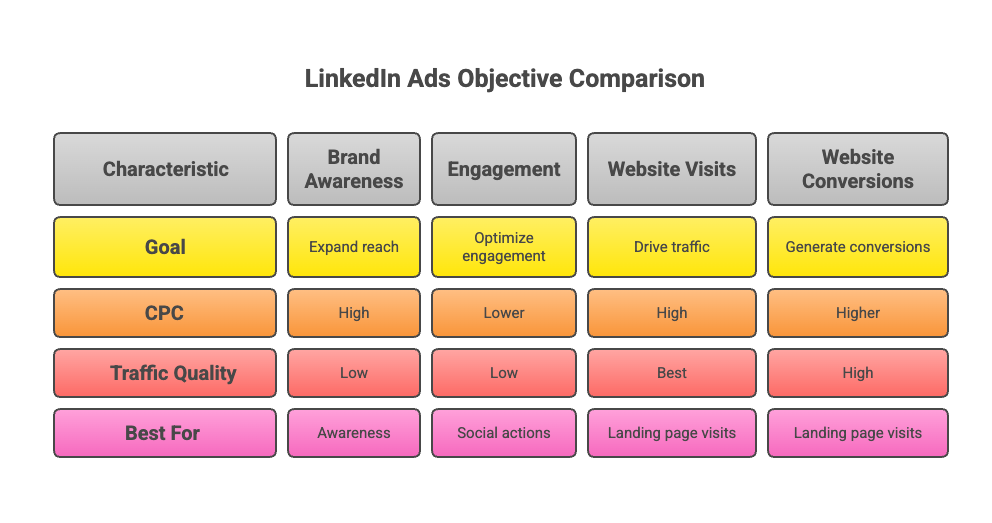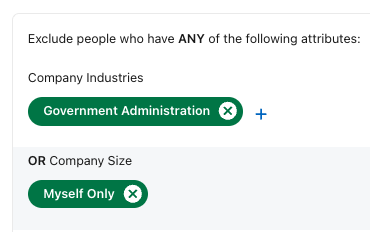After managing hundreds of LinkedIn traffic campaigns for B2B SaaS companies, I’ve learned that getting cost-effective traffic isn’t just about choosing the right objective. Most marketers focus only on bidding strategies and miss the bigger picture.
The reality is that LinkedIn traffic optimization requires three key elements working together: proper campaign setup, precise audience targeting, and compelling content that drives clicks. These are part of broader LinkedIn ads optimization best practices that can transform your campaign performance. Get one wrong, and you’ll either pay too much per click or struggle to get volume.
Through my experience, you can increase significantly your website traffic from LinkedIn ads using the same budget. The key is understanding how to make LinkedIn’s algorithm work for you instead of against you.
Key Takeaways
1. Website Visits Objective + Manual Bidding Wins: Start with bids 20% below the minimum range and adjust every two days based on budget delivery. This approach consistently delivers the lowest cost per click while maintaining volume control.
2. Audience Relevance Beats Audience Size: A 30k highly targeted audience will outperform a +100k broad audience every time. Higher relevance means higher CTR, which means lower CPC and more traffic with the same budget.
3. Content Type Matters More Than Creative Design: High-value content like surveys or reports on hot topics drives more clicks than perfectly designed ads with weak offers. Focus on solving real problems your ICP faces today, not theoretical future issues.
1. Choose the Right LinkedIn Ads Objective and Bidding Strategy
1.1 – What is the Best LinkedIn Ads Objective for Traffic?
Brand Awareness: This objective is perfect to expand reach and audience penetration but CPC is higher. As the name implies, it’s best for top-of-the-funnel, awareness content. But there’s a catch. You can optimize only for reach or impressions. And you will get a lot of reach and impressions since the algorithm will prioritize this action over the users that can perform a click so you’ll end up paying more for a click to the same audience.
Engagement: No real benefit in using this objective for driving traffic on your website. The engagement objective will optimize toward any sort of action on your LinkedIn ad. That means a social action such as a like, comment, or share; a follow to your company page; a visit to your company page; and even a click to your call-to-action link. In general you’ll get lots of comments and social shares but low quality traffic that’s not clicking to your landing page.
Website Visits: The best objective to get the best CPC for traffic optimization. If you want to send users to a landing page or website, you should always choose the “website visits” objective. With this objective you’ll pay only for clicks that go to a destination URL.
Website conversions: If you want to send the users to a landing page or website in order to generate traffic, you should choose “website visits” objective and avoid ” website conversions”.In most of the cases “website conversion” objective never outperform “website visits” objective because CPC and Cost per conversions are higher than website visits

1.2 – Bidding Strategy = Pay Less for a Click
The Right Optimization Goal
Clicks/Landing Page Clicks: If you select this optimization goal, LinkedIn’s algorithm will collect relevant data to make sure your ad is displayed only to audience members most likely to click on the URL. This will be based on each user’s individual past behavior (interactions with other ads in the past).
Bidding Strategy: Manual bidding gives you ample control over the CPC (cost-per-clicks) of your website visits campaign objective, meaning there’s little-to-no chance of overspending on your budget.
Moreover, LinkedIn will typically recommend a budget for each bidding strategy; whether or not you opt for it depends on your marketing budget circumstances. This recommendation will be based on two things: what your competing marketers are bidding and your campaign segmentation (how competitive your industry audience is).
How to Use Manual Bidding:
- Set the bid 20% below the minimal bidding range
- Have it run and check every two days if you are hitting your daily budget
- If not, increase bid. If above daily budget, decrease it (make sure to also have a look at targeting and content; the best bidding strategy won’t fix a bad setup)
This will ensure you get the most traffic at the best price and indirectly get much more clicks and traffic with the same budget.
Expert Tip: If you use this manual bidding the tactic ( bid low) keep in mind if your audience is broad the budget will be prioritized for the cheaper (junior) audience. This leads to a low CTR since your ads are intended for seniors and are simply irrelevant to junior people.
2 – Audience: Finding Relevance + The Ideal Volume
This can seem counter-intuitive at first, but you’re going to see why your LinkedIn ads audience is one of the most important factors when it comes to optimizing your LinkedIn ads campaign for traffic.
How to get more traffic on a campaign? If you think about it, you have to do the right technical setup and campaign optimization that indicates to LinkedIn your main goal is to get the most of your budget for getting the maximum visits. However, there is also a not-so-direct way to impact traffic optimization, and it’s all about getting more traffic with the same budget.
2.1 – The More Relevant Your Audience, the More Clicks and Lower CPC You’ll Get
Once you have the right ads and offer and your setup is correctly configured to maximize traffic, your second priority will be to lower the CPC by tweaking your audience.
But why does the audience have an impact on the CPC? It’s kind of simple logic. The more relevant your audience is, the more your content will resonate with it, and so you’ll increase the engagement on your ads, drive more clicks, and lower the CPC because you’ll get a higher CTR.
Does a Higher CTR Lower the CPC?
Yes, you’ve heard right. This is exactly how the algorithm works. LinkedIn sees a higher CTR as relevant, so if you get a crazy CTR, you’ll end up lowering CPC, and this means more traffic with the same budget.
How to Get the Most Relevant Audience?
Let’s take an example: you’re selling an e-signature software and you know your ICP are finance and operations C-level. If you’re marketers to your audience because you want to increase the pool of your audience thinking this will increase your traffic, this will be a huge mistake. So many times people think the more LinkedIn members I have in my target audience, the more traffic I will get.
Totally wrong. What matters is to get the right audience that faces the challenge your content will solve.
If you want to advertise to everyone, you’re randomly showing your ads to people who are not interested. It’s like putting a huge billboard on the highway. People will see it passively but not be hooked or interested at all because they don’t feel it’s for them.
Another great way to increase the precision of your audience is to use the criteria of company (company size and company industry).
You can increase your precision by playing with exclusions (e.g., excluding “Government Administration” industry because you already know that any official public administration can’t use software as a digital signature).
Also exclude solopreneurs with the “Myself only” company size attribute.

On the other hand, you probably have some industries that are in need of your tool. For example, you know that legal and/or staffing companies are primary users of an e-signature tool due to their job.
So use: Job titles + Company industry Or: Job function + Skills + Company industries
2.2 – LinkedIn Members and Industries Have Different Values
Before creating your audience for traffic, you need to know that not all industries and/or jobs are worth the same.
The more competitive and solicited your audience is, the higher you’ll pay. Logically, most of the advertisers on LinkedIn are targeting decision-makers that belong to C-level management. So be ready to pay way more for this kind of seniority than a simple senior or manager. A Chief Information Security Officer of a +10,000 company will cost you maybe $12 to $16 a click, meanwhile an HR specialist will cost you half this cost.
Another factor is the industry. Sectors like Information Technology are highly targeted, and if you combine the sector with the most solicited job functions, you’ll pay higher for this traffic.
2.3 – Find the Right Volume
Let’s go straight to the point. If your audience is too big, you’ll have lots of irrelevant users, and if your audience is too low, your CPC will increase because the volume segment is probably too low to get enough people interested in your content.
What is the Ideal Audience Size?
Difficult to give a round number since this will depend on the relevancy of your targeting. It’s better to have a 10k audience size with only interested members in the problem you solve and content than 50k of broad targeting with members out of scope.
However, from our experience, a size between the range of 30k and 80k is ideal for traffic objective. When you want to do lead gen, you can go a little bit lower, but if you need traffic, it will be difficult to get a good CTR with a low volume audience.
3. Ads Optimization for Maximum Traffic
3.1 – Type of Content That Drives Traffic
High Value Content
- A survey or report on a hot topic usually performs way better
- Use Document Ads or shorter content with clear, actionable insights
- Focus the content on real problems that your ICP faces today (not in 10 years)
- Stick to the point and make it easy to consume
- Involve your customers and targeted audience in the asset creation
Irresistible Offers
This could be an alternative to the high value content. Using an irresistible offer like a free audit or assessment. Otherwise, offering a free trial or free credits to use your solution could also work well.
3.2 – Lower the CPC with High CTR and Relevance
Your ad creative directly impacts your traffic optimization through CTR improvement. Here’s what works:
Compelling Copy: Write headlines that speak directly to your audience’s pain points. Use the problem-solution format that makes people want to click to learn more.
Contrast Colors: Use colors that stand out in the LinkedIn feed like purple, black, red or green. Avoid LinkedIn’s blue color scheme in your visuals to create contrast and grab attention.
3.3 – Best Format and Type
Best Ad Type: Single images work best for traffic optimization. They’re simple, load fast, and don’t distract from your main call-to-action.
Best Format: Square images (1:1 ratio) tend to perform better for traffic campaigns as they take up more space in the feed and are both adapted for mobile and desktop device.
Conclusion
The key to traffic optimization is the combination of proper technical setup, relevant audience targeting, and compelling creative that makes people want to click. Focus on getting these three elements right, and you’ll see your traffic costs decrease while volume increases.
If you need help implementing these strategies or want to scale your LinkedIn traffic campaigns faster, our LinkedIn ads agency specializes in helping B2B SaaS companies optimize their ad performance. We’ve used these exact methods to help dozens of companies achieve their traffic goals.
You might also be interested:


